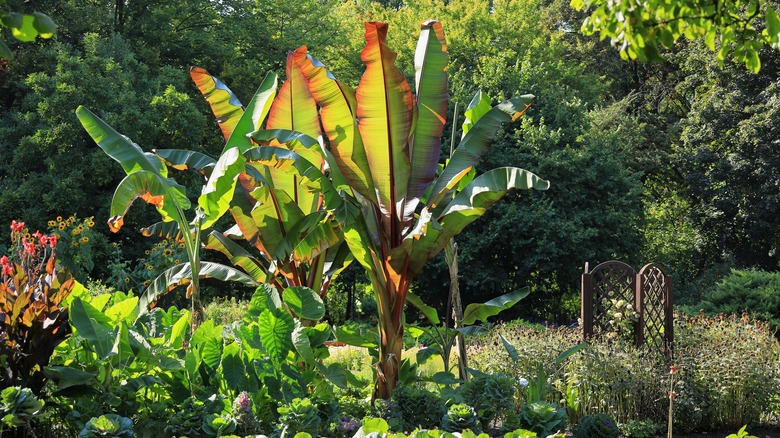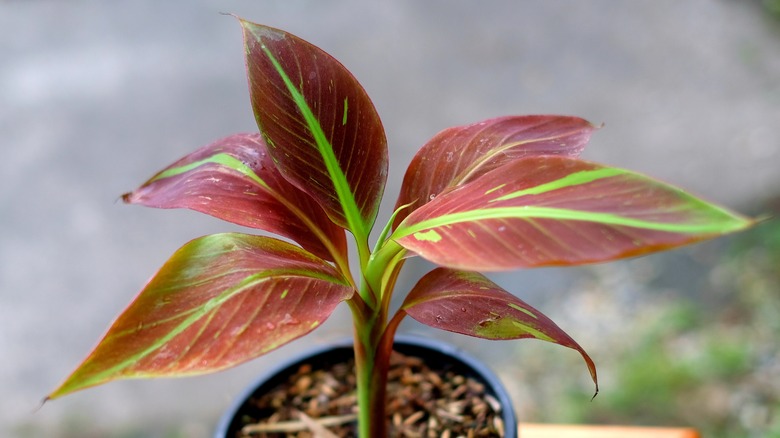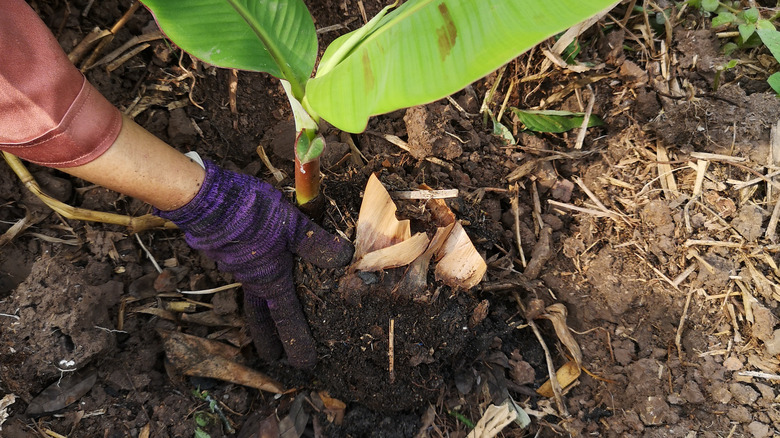Everything You Need To Know Before Planting A Red Banana Tree In Your Yard
You've heard red banana trees are the ultimate addition to any tropical-vibes backyard. The trouble is, there are a bunch of plants with "red banana" in their common name. Do you go for one of the many maroon-hued Musa acuminata cultivars, or would the banana look-a-like Ensete ventricosum 'Maurelii' better suit your yard? Before getting out your shovel and digging a big hole, you need to decide which species or cultivar you prefer. They all have different attributes: aesthetics (say, the ratio of red tones to green), their height and breadth, and whether (or not) they're considered cold-tolerant tropical plants.
Search "red banana tree" or "red banana plant" online, and you'll come across lots of information on the Musa species and its hundreds (and counting) of cultivars. It's perhaps unsurprising, considering pretty much every common edible and ornamental banana counts one of just two wild plants — Musa acuminata or Musa balbisiana — as a parent. However, of the many cultivars, just a few feature red stems and leaves. What's more, only the more established cultivars are available for purchase by U.S. gardeners. Equally, you'll find results about a rival red banana tree, Ensete ventricosum 'Maurelii'. Which is better suited to your needs depends on your USDA Hardiness Zone, space in your garden, and, to be frank, simple personal preference.
Cultivar clarification
Musa 'Siam Ruby' is a "small" banana by banana standards (it still grows to 6 feet tall) with vibrant foliage ranging from terracotta to maroon. It numbers among the dwarf fruit trees that are perfect for a smaller yard. If it flowers for you (it rarely does so), any resulting fruit isn't edible. Another rich red variety is Musa 'Red Iholene' — the leaf underside and stem are crimson, and, in this case, the fruit is tasty. Some cultivars boast green leaves shot through with ruby — called variegation. The popular Musa acuminata 'Zebrina' is known, albeit a little eerily, as the blood banana due to the splashes of blue-red on its leaves. Musa sikkimensis 'Red Tiger' also has, as its name implies, stripey leaves and a red stem, as does Musa 'Bordelon' and the enormous Musa sikkimensis 'Darjeeling Giant'.
The other plant that nursery owners and amateur gardeners alike commonly refer to as a "red banana tree" is the cultivar Ensete ventricosum 'Maurelii' — also called red Absynnian or Abysinian, red, red false, or wild banana. Like the Musa cultivars discussed above, it's in the Musaceae family and is essentially a giant herb, not a tree. Today, the parent plant, Ensete ventricosum, is an important food source in its native Ethiopia. Though the maroon-hued Maurelii variation does produce edible fruit, it's far more popular for landscaping in the U.S. due to its size — it can grow 10 feet tall by 8 feet wide — and its lush tropical aesthetic.
Get growing
Getting your hands on some of the more obscure red banana tree cultivars can be tricky; many new cultivars are developed overseas. In mid-2021, the United States Department of Agriculture banned imports from major banana-producing countries to prevent the spread of the fungus, Fusarium oxysporum. However, finding red Absynnian and established Musa cultivars in the U.S. isn't a problem. Walmart has Ensete plants in 4-inch pots for $30.85 each. Plant Delights Nursery at Juniper Level Botanic Garden has Musa 'Siam Ruby' trees in a 2-quart pot for $32.00. Remember, these are monocarpic plants, meaning they flower once and die, so expect to replace a plant every so often.
Once your sapling arrives, plant it in a sizeable, well-draining container or uncrowded spot in your garden. Cover the ground with mulch, and keep the soil damp to the touch but not soggy. Fertilize these nutrient-hungry plants often in the growing season with an 8-10-8 fertilizer. Some red banana trees tolerate low temperatures — about 30 degrees Fahrenheit for Ensete and some Musa species; those in USDA Hardiness Zones 4 to 8 must overwinter their plants. Dig it up before the first frost, pop it in a large pot, or wrap it with plastic. Keep the plant inside through winter, then, come spring, replant it outside. Alternatively, you can cut it close to the ground and cover it with a thick layer of mulch. Uncover the stumps when the weather warms, and they should resprout.


